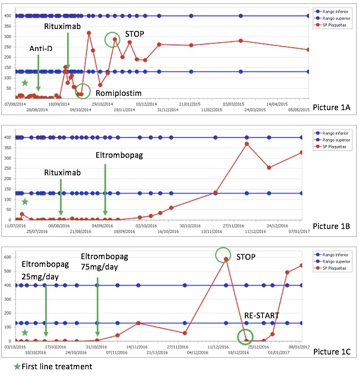
Contributions
Abstract: PB2122
Type: Publication Only
Background
Immune thrombocytopenia (ITP) is an autoimmune disease in which antibodies develop against platelets (plts) and dysregulation of cellular immunity result in premature destruction of plts and impaired plt production. For most affected children, ITP is a self-limiting disease. Approximately, 10% of all ITP patients eventually develop refractory ITP (RITP). Thrombopoietin receptor agonists (TPO-RA) stimulate thrombopoiesis and are an alternative to Rituximab (Rtx) and splenectomy.
Aims
We present 3 different children with RITP treated with TPO-RA.
Methods
CASE 1
Results
In all cases, splenectomy was avoided due to long-term risk of sepsis, as well as immunosuppressive agents like RTX in 3rd case. In 1st case, TPO-RA was able to stop with sustained response as described in some publications.

Conclusion
In our experience, TPO-RA appear to be efficacy and well tolerated in children.
Session topic: 32. Platelets disorders
Keyword(s): Thrombopoietin (TPO), Thrombocytopenia, Childhood
Abstract: PB2122
Type: Publication Only
Background
Immune thrombocytopenia (ITP) is an autoimmune disease in which antibodies develop against platelets (plts) and dysregulation of cellular immunity result in premature destruction of plts and impaired plt production. For most affected children, ITP is a self-limiting disease. Approximately, 10% of all ITP patients eventually develop refractory ITP (RITP). Thrombopoietin receptor agonists (TPO-RA) stimulate thrombopoiesis and are an alternative to Rituximab (Rtx) and splenectomy.
Aims
We present 3 different children with RITP treated with TPO-RA.
Methods
CASE 1
Results
In all cases, splenectomy was avoided due to long-term risk of sepsis, as well as immunosuppressive agents like RTX in 3rd case. In 1st case, TPO-RA was able to stop with sustained response as described in some publications.

Conclusion
In our experience, TPO-RA appear to be efficacy and well tolerated in children.
Session topic: 32. Platelets disorders
Keyword(s): Thrombopoietin (TPO), Thrombocytopenia, Childhood


